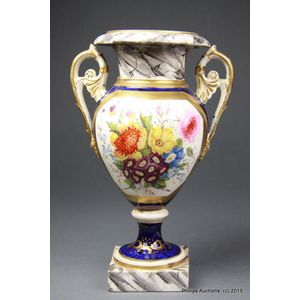Hanau Bacchanalian Silver Urn Vase with Grapevine Swags
You must be a subscriber, and be logged in to view price and dealer details.
Subscribe Now to view actual auction price for this item
When you subscribe, you have the option of setting the currency in which to display prices to $Au, $US, $NZ or Stg.
- Hallmarks - A mark stamped on articles of precious metals in Britain, since the 14th century, certifying their purity. It derives its name from the Guild Hall of the Goldsmiths' Company, who recieved its Charter in 1327 giving it the power to assay (test the purity) and mark articles of gold and silver.
The hallmark will consist of several marks, including the:
- silver standard mark, indicating the purity of the metal. Sterling silver is .925 pure silver.
- the city mark indicating the city in which it was assayed eg London, Birmingham, York etc.
- the date mark, usually a letter of the alphabet in a particular font and case,
- a duty mark, indicating whether duty had been paid to the crown, and only in use from 1784 to 1890
The piece may include an additional mark, the maker's mark, although not forming part of the hallmark, will be located in the vicinity of the hallmarks.
Sometimes silver plated items will bear faux hallmarks, often confusing those not familiar with silver markings. - Floral Swag / Garland / Festoon - Floral swags are a decorative motif often used in the ornamentation of various objects, such as silverware, glassware, and furniture. The term "swag" refers to a garland or wreath of flowers, foliage, or other decorative elements, which is usually arranged in a loop or curve.
Floral swags can be found in a variety of decorative styles, from ornate Baroque and Rococo designs to more naturalistic Art Nouveau and Art Deco styles. They are often used to add a touch of elegance, refinement, or whimsy to an object, and can be seen on a range of items from chandeliers and candlesticks to picture frames and tea sets.
In the decoration of silver objects, floral swags are often used to accentuate the curves and lines of the piece, and to add visual interest to the surface. Similarly, on glass objects, floral swags may be used to frame or highlight a particular area of the object, or to add a touch of color and delicacy.
On furniture, floral swags can be found on a variety of pieces, from cabinets and armoires to chairs and sofas. They are often used to enhance the lines and curves of the furniture, and can be used to create a sense of movement and flow in the design.
Overall, floral swags are a versatile decorative element that can be adapted to a range of styles and applications, and have been used in the decoration of various objects throughout history. - Grapevine Motif - The grapevine motif is a decorative design that features grapevines, leaves, and grapes and is commonly used in various forms of art and decoration, including jewellery, textiles, pottery, and architecture.
In jewellery, the grapevine motif is often used to create decorative elements such as pins, brooches, necklaces, and bracelets. The design can be executed in a variety of materials, including precious metals such as gold and silver, and can be embellished with gems or enamel.
The grapevine motif is a popular symbol in many cultures, representing abundance, prosperity, and fertility. In ancient times, grapevines were associated with Dionysus, the Greek god of wine and celebration, and were used to decorate wine vessels, temples, and other sacred objects.
In addition to its cultural significance, the grapevine motif is also appreciated for its aesthetic appeal. The intertwining branches and clusters of grapes create a graceful, flowing design that is both beautiful and versatile. Whether used in jewellery, textiles, or other forms of decorative arts, the grapevine motif continues to be a popular and enduring symbol of abundance and prosperity.
This item has been included into following indexes:
Visually similar items

An Edward VII sterling silver milk jug, raised on square foot base. Williams (Birmingham) Ltd, Birmingham 1910. Weight 87g. Height 10.3 cm. (dents)

A Royal Vienna royal blue and cherub decorated gilded handled vase and cover

Magnificent 19th century French ormolu twin handle vase, after Clodion and cast by F. Barbedienne, of classical form, decorated with a raised frieze of classical figures. Flanked by mythical mask handles, on waisted fluted support, on foot, signed F. Barbe

A floral Staffordshire urn, circa 1815-20, of typical urn form with decorative scroll handles, upon a small spreading foot raised on a faux marble plinth, the body in deep cobalt blue with gilt scrolls and decorated to a reserve with vibrant summer blooms
